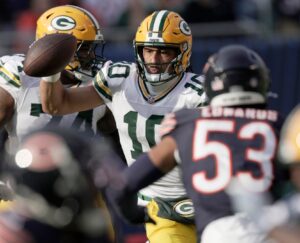Jamaal Williams led the BYU Cougars in rushing yards in all four years that he played there. Williams played immediately as a freshman and started eight games in his first season. Over his college career, Williams ran for 3,901 yards and 35 touchdowns, averaging 5.4 yards per carry.
Pittsburgh Steelers Should Draft Jamaal Williams
Williams decided to take a year off from school in 2015 due to personal reasons, but returned in 2016 seemingly better than ever. Williams finished fifth in the country in rushing yards per game last year with 137.5 yards per game, thanks in part to a 287 yard and five touchdown performance against Toledo.
Le’Veon Bell Needs a Backup
Backup running back DeAngelo Williams is still unsigned and it’s unclear if the Steelers will decide to keep him on the roster. Williams is 33 years old and made $2 million last year. The Steelers also signed former Kansas City Chiefs running back Knile Davis to a one-year deal worth $775,000 this offseason. Davis is a nice addition, but it’s still unclear if he’ll be a good fit as a backup running back in Pittsburgh.
After that, Fitzgerald Toussaint has been the Steelers next running back down the list. Touissant hasn’t made much of an impact in his time as a Steeler and hasn’t shown the ability to be a true number two running back behind Le’Veon Bell. When Williams went down with an injury last season, Bell had to carry quite a heavy workload because of the team’s lack of faith in Touissant.
NFL Combine Statistics
At the NFL Combine, Williams measured in at 6 feet tall and 212 pounds. His arm length was measured at 31 and ¼ inches, and his hands were measured at 10 inches. Williams ran the 40-yard dash in 4.59 seconds, which isn’t all that fast, but isn’t slow by any means either. He completed the three-cone drill in 7.25 seconds and the 20-yard shuttle in 4.53 seconds. Williams recorded a 123-inch broad jump and a 30-inch vertical leap.
Question Marks
Williams had some off-the-field issues at BYU, including a suspension during his junior season for multiple team code violations, including an underage drinking citation. As stated earlier, Williams sat out the 2015 season for personal reasons, but it seemed to do him some good since he returned in such impressive fashion in 2016.
Williams needs to work on his patience when looking for a running lane. He sometimes gets a bit too antsy and runs into his own blockers. Williams is a banger and a power runner, but his forward lean causes some issues with his contact balance. He lacks elite breakaway speed, but can still break off some long runs.
Strengths
Williams is an exceptionally versatile runner, combining size, quickness and elusiveness. He’s also a good pass-catcher and made plenty of plays coming out of the backfield as a receiver. Williams made an immediate impact as a receiver during his freshman season, accumulating 315 receiving yards and a touchdown on 27 receptions.
Williams is explosive and hard to bring down singlehandedly, as he often runs through arm-tackles. He’s shown that he is dependable and durable, only missing eight games due to injury over his four years at BYU.
Williams would be a solid backup to Bell, bringing a change of pace with his power running and explosiveness. He can learn how to be more patient, which is his main weakness, from the best in the game. Bell is known for his incredible patience before hitting the hole and he can show Williams how to improve in that category. He wouldn’t be asked to do a lot right away, especially now that Davis has signed, so he could take time and develop behind arguably the best running back in the NFL.
Main Photo:






